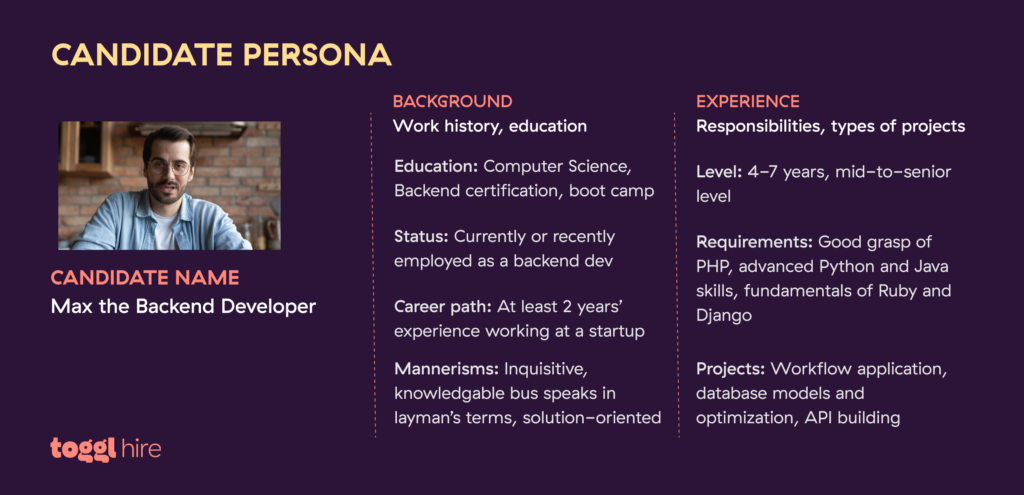When job seekers scan job descriptions, they typically run through a mental checklist of the job requirements section: “Good at this, have experience with that, always wanted to learn this, 3 years of experience managing a CRM? Nope, they won’t take me.”
And just like that, you lose great-fit potential candidates.
To attract qualified candidates that fit your company culture (and don’t self-reject after learning the job duties), you need an accurate list of essential and preferred job requirements. Not a laundry list of “nice-to-haves!”
Including clear, concise requirements in your job postings can help your organization connect with qualified job seekers who have the necessary skills to succeed in the role and will stick around and make a difference.
TL;DR — Key Takeaways
Job requirements are the list of skills and qualities you’re looking for in a candidate. Some components will be a “must” for the role, while others will be “nice-to-haves.”
These job requirements form an important part of the full job description, helping the hiring manager target candidates with the right skills and kickstart the candidate screening process.
The dos and don’ts of writing great job requirements include writing the copy concisely and clearly and using bullet points. We also suggest ensuring the requirements list isn’t so long that it scares off potential candidates.
Finally, we look at the eight core components to include in your job requirements to ensure job seekers get the info they need to decide if the role is a match for their skills and work experience.
What are job requirements?
Job requirements are the parameters or capabilities a candidate needs to successfully perform the duties of a specific job. These specs include the qualities and skills that are required, along with those that are preferred, together making up the ideal candidate.
Typically, the job requirements section includes:
Desired education level
Work experience
Any specific hard skills required, such as C# programming
Professional licenses or accreditations
Personal traits that match or complement the company culture
These specs form a vital part of the overall job description and help prospective employees establish whether their skills and experience match up.
Why are job requirements so important?
Clear job requirements are essential for creating effective job descriptions. By specifying exactly what job seekers need to succeed in the role, you can effectively turn job requirements into a pre-screening tool.
By acting as the first selection component in candidate pre-screening, these criteria help the hiring manager:
Begin pre-screening by attracting predominantly qualified candidates
Communicate the minimum requirements for the role, such as a Bachelor’s Degree in Data Science
Streamline the hiring process by reducing the number of ‘chance takers’ or unqualified candidates
Reduce hiring costs as the team would have fewer applicants to screen
Balancing the essential vs. preferred requirements
One thing to remember is that the job requirements wording must strike a balance between what’s essential for the job (such as specific skills like AWS certification) vs. the nonessential qualities (like experience leading a team).
If we think of how someone chooses the dog or cat they want to adopt, there’ll be some ‘must-haves,’ such as female and well-behaved around children. There will also likely be one or two ‘nice-to-haves’ like ginger-colored fur and a young. However, most people don’t need a pet to tick all the boxes to find one that melts their hearts! 🐕
We don’t want to compare pets to candidates, but the hiring process is similar. The ‘must-have’ skills are necessary for the person to do the job well, while the ‘nice-to-haves’ aren’t essential to success in the role but would likely speed up the candidate’s onboarding or give them an edge over other applicants.
Don’t make the job requirements too restrictive as you could chase away potential good candidates!
Do’s and don’ts when writing job requirements
Still stuck on why your job ads aren’t attracting candidates? We’ve put together a few guiding principles to help you successfully craft the job requirements section and attract good-fit job seekers.
| Consider | Best Practice |
|---|---|
| Job Task Analysis | If you’ve already created a job task analysis or job analysis (a detailed breakdown of a role’s core responsibilities and tasks), then extract the job requirements details from that info. |
| Length | Keep it concise, sticking to essential info only. That way, you avoid any confusion or potential biases. |
| Formatting | Use bullet points so the job requirement description is scannable. |
| Targeting | Craft the wording to suit the candidate persona (a description of the ideal candidate for that role). |
| Branding | Stick to your employer brand tone of voice. In other words, in line with the company’s ‘personality’ or culture. |
| Nice-to-haves | Also, add in the preferred requirements, such as experience in the healthcare industry or other preferred areas of knowledge. |
What to avoid when outlining job requirements
Don’t write a long list of requirements that’s so long it scares most potential candidates from applying.
Don’t include specs that don’t match up with the job title or the rest of the job description, such as requiring five years’ relevant work experience for a junior developer role.
Don’t let spelling or grammatical errors slip into your job requirements or job description copy.

8 examples of requirements to include in the job description
Think about what prospective candidates need to know so they can scan through the list and make sure their qualifications and experience match the job posting. See which relevant points to include in your job listing while keeping the copy scannable.
1. Technical and hard skills
Technical skills are the specialized skills and knowledge an applicant needs to successfully perform on the job. If the role is highly technical, a person without the right hard skills will not be able to perform the tasks, job responsibilities, and duties. For example, hands-on experience with C# programming.

2. Soft skills
Soft skills, such as critical thinking or communication skills, can be equally important as hard skills in certain positions.
Think of a Customer Success Manager. Without excellent communication or relationship-building skills, they wouldn’t be very successful! Again, you don’t want to overwhelm candidates with a laundry list of requirements here, but listing a few desirable soft skills is a great idea.

Easily assess candidates’ technical and soft skills with our expert-crafted skills assessments.
3. Personal qualities and physical abilities
Along with the technical and soft skills, there may be particular traits (like physical abilities or personality traits) that would ensure a good fit for the position.
For example, a personal trainer would need to be in shape but also love teaching and motivating people. This job requirements example demonstrates what you might ask for in that case.

4. Years of work experience
The number of years of experience potential candidates need usually depends on the role’s seniority level.
If we consider the levels of relevant experience for a software engineer, then a junior would typically have 1-3 years of experience, a mid-level candidate should have approximately 3-5 years under the belt, and a senior engineer would likely have 5+ years’ experience.
While this is helpful to include, ensure you’re being realistic. Don’t require 5+ years of experience for a junior, low-paying role.

5. Education, qualifications, and certifications
Include details on the qualifications, educational requirements, and any specific certifications the role requires. For instance, decide whether the job requires a high school diploma, college degree, or graduate degree.
For example, a cybersecurity analyst will need a university degree and specialized security certifications. Here’s a great example we found of what that could look like when listing the job requirements.

6. Travel requirements
Some positions require employees to travel locally or internationally. For instance, an events manager would need to travel to events to ensure they’re on site and keeping everything running smoothly, while a consultant is required to travel to the client site while working on their projects. If that’s the case, make that clear!
7. Language requirements
If the job duties require the person to speak a specific language (or languages), then those details should be included in the job’s requirements. For instance, if the job position involves dealing directly with global customers, such as customer service or international sales.
To assess fluency, you can use standardized tests in different languages, do interviews in a foreign language, role-play situations, or have candidates do self-assessment.
8. Working hours
Sometimes, a job entails working very long hours. This is often the case for people in the medical or law field, but also for positions in business administration, like a sales manager or C-suite role.
While these types of candidates are likely to understand that’s just part of the position, it’s still helpful to be transparent about those working conditions in the job requirements.
Bonus: Job requirements copy examples
Not all of the points above will apply to every job posting. You can select which are required and preferred for the job description you’re creating.
To help you out with how to write the job requirements copy, here are a few examples of good and bad bullet points for the job posts for a junior product designer position.
✅ Bachelor’s Degree in Experience Design, Human-Computer Interaction, Graphic Design, Computer Science or equivalent. (It’s clear and is not too limiting)
❌ Must have an MS/MA degree. (The requirement is clear but very restrictive)
✅ 1-2 years of experience in professional UX design. (Reasonable years’ experience requirement for a junior role)
❌ 5+ years of experience in professional UX design. (Unreasonable length of experience for someone that’s still a junior)
✅ Experience with design tools, such as Sketch or Figma. (Not too prescriptive)
❌ Must be highly proficient with Figma (Very restrictive, as the person can become more proficient quickly, and they may use a different but similar tool)
Make sense? Sure it does—you’ve got this! But remember, the more hoops to jump through, the slower the pace of your hiring process. Keep it smooth and seamless. 😉
Start attracting better candidates
If your team finds the screening and selection process frustrating, Toggl Hire offers an all-in-one platform for screening, assessing, and hiring candidates based on their actual skills!

By incorporating skills assessments, you can help your team identify the real talent quickly and ensure your screening process is fast and reliable. Create your free account today to build your custom hiring pipeline in minutes (skills assessments aren’t the only assessment feature we offer, by the way 😉).
Juste loves investigating through writing. A copywriter by trade, she spent the last ten years in startups, telling stories and building marketing teams. She works at Toggl Hire and writes about how businesses can recruit really great people.








